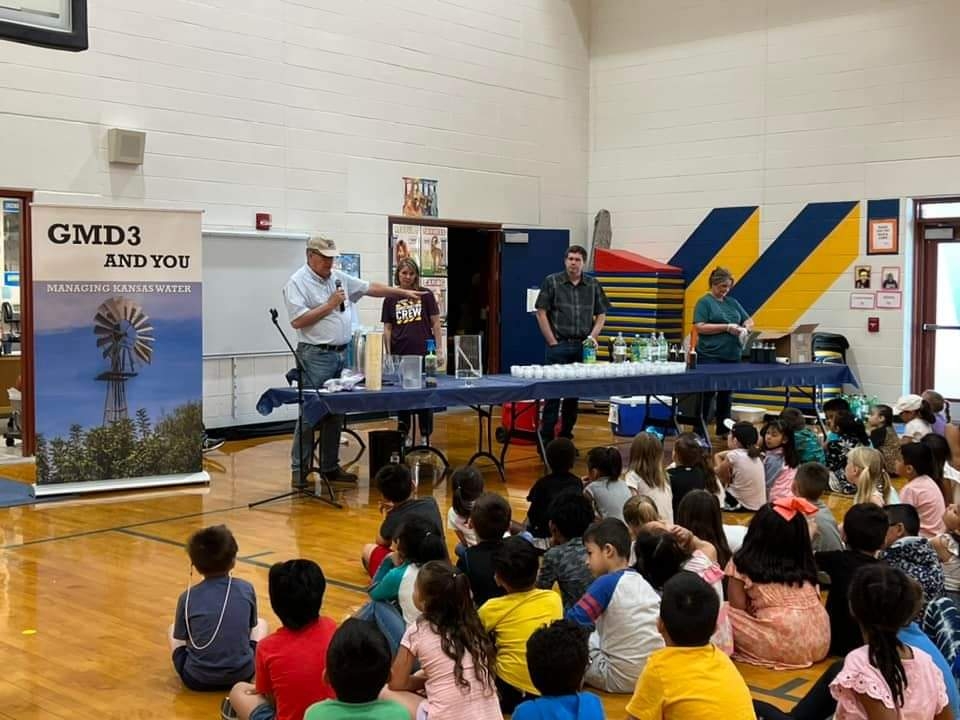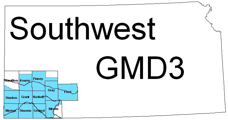

Our Mission
Act on a shared commitment to conserve and develop water supply to grow the social, economic, and natural resources well-being of the District for current members and future generations in the public interest
INTRODUCTION
Groundwater Management Districts (G.M.D.s) is part of our Kansas government system. They were established in Kansas law. The official local thinking for logical water policy and behavior is a public right of a G.M.D. Regular updates help improve thinking. The through-line of this official Management Program document for protecting public health and welfare is to conserve and develop water supply resiliency using the activities and interdependent roles with water management partners to fulfill the governing body’s mission. GMD3 seeks to protect and enhance the instrumental and intrinsic values of water enjoyed by all. This document outlines six program activity areas: 1) Water Rights Administration Assistance; 2) Water Conservation; 3) Models, Research and Development; 4) Water Quality Protection; 5) Ark River Management; and 6) Outreach, Advocacy, and Education.
PURPOSE FOR LOCAL GROUNDWATER MANAGEMENT
The G.M.D. Act and “the right” to manage groundwater use. In K.S.A. 82a-1020, the legislature set two elements of policy in law for groundwater management: “…to preserve basic water use doctrine and to establish the right of local water users to determine their destiny with respect to the use of the groundwater insofar as it does not conflict with the basic laws and policies of the state of Kansas.” These activities assure that each person can do their part in keeping our communities healthy and economy strong regarding water supply and use.
Objectives of the legislature for G.M.D.s:
- Proper management of the groundwater resources of the state.
- Conservation of groundwater resources.
- Prevention of economic deterioration.
- Associated endeavors within the state of Kansas through the stabilization of agriculture.
- To secure for Kansas the benefit of its fertile soils and favorable location concerning national and world markets.
Purposes for which GMD3 was organized in 1976:
- Organize and develop the efforts of the entire Groundwater Management District for the proper management and conservation of its groundwater resources.
- Provide local input into the use and management of groundwater.
- Provide the most significant total social and economic benefits from the development, use, and management of groundwater.
- Support research and education concerning proper water management.
- Work cooperatively with all federal, state, and local government units to accomplish the objectives of the District and the G.M.D. Act and amendments thereto.
Public Interest. Under the declarations of the G.M.D. Act (82a-1020 et seq.), the management program document and activities of the elected volunteer governing body of GMD3 (Board) are considered the local expression of public interest relative to groundwater management issues and associated endeavors. This program update must be submitted to the chief engineer for approval, and the chief engineer must approve it if it is compatible with the provisions of the Kansas Water Appropriation (K.W.A.) Act and other basic laws and policies of the state.
Water use in GMD3. In the driest part of the state, water use in the District occurs directly from precipitation or diverted from the state’s waters according to water rights owned by the members of GMD3 and administered according to the Kansas Water Appropriations Act. Generally, groundwater use is declining in the District with time as stored supplies are mined under state-issued legal water rights, and pumping rates are exceeding groundwater replenishment rates. For established legal purposes other than produced water associated with oil and gas exploration, water use is supervised under the prescribed duties and powers of the state Chief Engineer and Division of Water Resources (KDA/DWR) staff, who are advised and assisted in the District by GMD3 to implement the public interest of the management program. With supply and demand out of balance across the state, the future economy of Kansas depends on big planning, funding, and brave actions from servant leaders at all levels, including the members and governing body of GMD3. Groundwater management can be difficult for many reasons that include:
- Groundwater is a shared resource.
- Groundwater inflows and outflows are difficult to observe and cannot be measured directly.
- Surface water and groundwater are interconnected.
- Aquifer boundaries and characteristics may be locally unknown or poorly defined.
- Groundwater management requires specialized model tools.
- Groundwater conditions can vary on multiple time scales.
- Groundwater use can pit present needs against future needs.
- Diverse local, state, and federal interests, institutions, and authorities require significant coordination and outreach activity to secure the necessary productive partnerships.
GMD3 Members. A GMD3 member is an eligible voter described in the G.M.D. Act (K.S.A. 82a-1021(a)(5)). Basically, any water user of an acre-foot or more annually or an owner of 40 or more contiguous acres of land in the District is a member. Most domestic well users in the District annually use at least one acre-foot (325,851 gallons) of groundwater to be considered eligible voters of the District. A person must be a member of the District to be eligible to serve on the GMD3 governing body. Members find ways to tie their work and life to four core values in their water management and balance between them in no particular order (See S Lauer, Social Aspects of Groundwater Conservation, 2020): Individual Responsibility – Members desire the ability to make their own water project decisions based on what they believe is best for their operations and families. Fairness – Members desire that the benefits and sacrifices involved in water management are equitably distributed. Community – Members desire to have good relationships with their neighbors and to have functioning towns with schools, hospitals, churches, and businesses. Stewardship – Members desire to preserve the benefits of groundwater for future generations. Individual members emphasize some values more heavily than others. The same cultural incentives for water conservation may also become cultural barriers when incentives are viewed as insufficient, conflicting, or inconsistently applied.
District Powers. To carry out the public right and purposes, GMD3 is granted an enumerated set of powers in K.S.A. 82a-1028 and amendments. In addition, other powers have been provided by the legislature or by state officials that include initiating IGUCA and LEMA proceedings and approving state required water conservation plans, described without limit as follows:
- S.A. 82a-1020 declaring the purposes of the G.M.D. Act and establish the public right of water users and landowners to determine their destiny regarding water use;
- S.A. 82a-1028(g) to construct, operate, and maintain such works as may be determined necessary for drainage, recharge, storage, distribution or importation of water, and all other appropriate facilities of concern to the District;
– K.S.A. 82a-1028(i) to contract with persons, firms, associations, partnerships, corporations, or agencies of the federal government and enter into cooperative agreements …
– K.S.A. 82a-1028 (m) provides advice and assistance in the management of drainage problems, storage, groundwater recharge, surface water management, and all matters of district concern;
– K.S.A. 82a-1028 (n) adopt administrative standards and policies relating to the management of the District, which is not inconsistent with the provisions of the G.M.D. Act or K.W.A. Act;
- S.A. 82a-1028(o), (p) & (q) to recommend rules & enforce them by suitable action.
- S.A. 82a-1028(r) to enter upon private property within the District for inspection purposes, to determine conformance of the use of water with established rules and regulations, including measurements of flow, depth of water, water wastage, and for such other purposes as are necessary and not inconsistent with the purposes of the G.M.D. Act;
- S.A. 82a-1028(u) recommend to the chief engineer the initiation of IGUCA proceedings.
- S.A. 82a-1029 adopt the official management program for the District; and
- S.A. 82a-1041 to recommend adopted LEMA plans for implementation.
- S.A.82a-1042 provides a formal response to any rules or G.M.D. management program changes proposed from the Sec. of Agriculture or Chief Engineer that may alter an adopted local groundwater management program or impact water use in the District.
- S.A.82a-733(g) jointly approve conservation plans required by the chief engineer.
- S.A.82a-745(d),(h) & (m) to advise in acceptable management plans for WCA’s; and
- S.A.82a-1906(b) notification to water users of certain applications under review by DWR.
FORMATION AND OPERATION OF GMD3
Lead from local need. In the 1960s, good, creative, local problem-solving people insisted on adopting mandatory standards, registration of groundwater water rights, supply and use limits, minimum well spacing, and special groundwater management area authority to protect local interests. Use limits began with policy to manage the groundwater depletion rate, and good state and local action followed. A public vote to form the District was held on February 24, 1976, following approval of the petition and the issuance of a report of public interest by the Chief Engineer. The vote resulted in 1,155 voters in favor and 230 opposed. Now all annual meetings are held on the second Wednesday of March unless changed with notice. GMD3 is governed by a 15-member volunteer Board of Directors that is elected by a general constituency of qualified voters who attend the annual meeting. Members may be elected to serve as one of the 12 county positions, and there are also 3 “at-large” Board positions designated to represent Municipal, Surface water, and Industrial use, respectively. An annual land assessment finances GMD3 activity, and groundwater user fees levied against the landowners and water users in the District based on a yearly budgeting process. A public hearing of the proposed budget and level of assessments needed to finance the budget is usually conducted in July. For 2017 through 2022, the land assessment has been $0.05 per acre, and the water withdrawal or “user” fee has been $0.14 per acre-foot.
Table 1. Eligible land for assessment and appropriations for a water user fee (2018).
| County | Total Assessable Acres | Assessed Acres | Excluded Acres | Wells |
Authorized Acre Feet |
| Finney | 625,637.27 | 624,438.81 | 1,198.46 | 1,085 | 581,233.00 |
| Ford | 662,719.10 | 662,006.70 | 712.40 | 660 | 200,531.00 |
| Grant | 357,715.95 | 357,570.35 | 145.60 | 642 | 328,266.00 |
| Gray | 536,554.15 | 536,063.78 | 490.37 | 1,303 | 420,880.00 |
| Hamilton | 71,209.95 | 71,209.95 | 0.00 | 73 | 40,871.00 |
| Haskell | 359,790.37 | 359,696.36 | 94.01 | 907 | 461,581.00 |
| Kearny | 449,230.77 | 448,767.60 | 463.17 | 494 | 233,298.00 |
| Meade | 399,646.59 | 399,449.21 | 197.38 | 553 | 278,636.00 |
| Morton | 481,659.65 | 481,414.11 | 245.54 | 307 | 129,058.00 |
| Seward | 381,891.63 | 381,566.10 | 325.53 | 501 | 281,904.00 |
| Stanton | 439,975.96 | 439,848.76 | 127.20 | 625 | 333,354.00 |
| Stevens | 467,219.07 | 467,018.89 | 200.18 | 705 | 383,949.00 |
| GMD3 totals | 5,233,250.46 | 5,229,050.62 | 4,199.84 | 7,855 | 3,673,561.00 |
GMD3 Office. The District is managed from an office located at 2009 E Spruce Street, Garden City, Kansas, and is operated by the board of directors who is responsible for setting policy and objectives for the District and employing the professional staff needed to carry out GMD3 program activities. As much local input as possible is directed at new and improved methods of managing the District water supply. The board of directors generally meets the second Wednesday of each month and all meetings of the governing body are open to the public in compliance with K.S.A. 75-4319.
